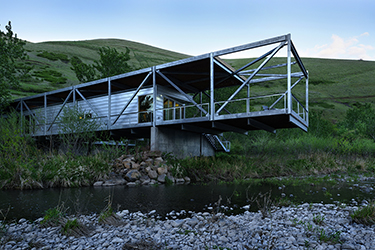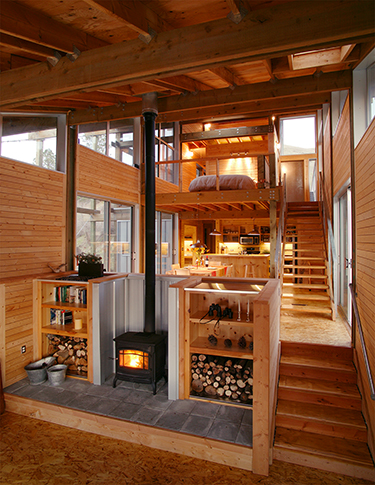|
Subscribe / Renew |
|
|
Contact Us |
|
| ► Subscribe to our Free Weekly Newsletter | |
| home | Welcome, sign in or click here to subscribe. | login |
Architecture & Engineering
| |
June 22, 2018
WSU prof honored for long ‘obsession' with both architecture and landscape
Journal Staff Reporter
When Washington State University professor and architect Paul Hirzel was designing The Canyon House on the Clearwater River in Juliaetta, Idaho, he spied an amazing basalt knoll about 200 feet above the water.
“The impulse might have been to put the house there,” he said, “but this is too remarkable a wild place to put a building on it.”
He didn't.
He and the client agreed to construct two buildings on the steep site instead of one. The Studio House is built on a finger ridge, where Ponderosa Pine forest changes to meadow, and people inside are eye level with eagles flying above the river. The Bunk House sits in a sheltered ravine on a seasonal stream.
The basalt knoll remains wild.
Hirzel has an affinity for what's outside the box — and for inviting the outside in.
As an architecture professor in the School of Design and Construction, he emphasizes the significance of landscape. He has won national awards for teaching, as well as national, regional and local AIA awards for design.
Some of his work is being featured until Nov. 25 at the prestigious 2018 Venice Biennale. His approach to design emphasizes expression of the structure, economy of means in construction and responsiveness to the site.
The fourth edition of the biennial architecture exhibition — “Time Space Existence” — is hosted by the European Cultural Centre, and presents works from architects, photographers, sculptors and universities around the world.
Hirzel pushes himself and his students to advocate for including natural elements such as vegetation and even the sky as “building materials.” He said these elements are in many ways more important than steel, glass and concrete.
“Buildings are part of the solution,” he said. “They are not the whole solution.”
He wants to create places for people to observe the outside world. “The more the architecture can include the landscape, the more treasured the experience that the architecture brings to the world,” he said.
Hirzel said too often houses are put smack in the middle of a property, with the landscape “as some sort of leftover.” Rather, they could be located to the side, giving them equal or better footing.
Even in urban areas where buildings go up to the property line and sometimes touch one another, architects can find ways to bring the outside inside, with rooftop gardens, courtyards and wider sidewalks with cafes, he said.
The professor said buildings also could have “more provocative relations to the sky” by using larger windows, light wells and reflective materials to bring in light.
“My goal is to help overcome this strange separation between building and landscape,” he wrote in an essay for the Venice Biennale exhibition catalog.
Hirzel is a voracious learner. He holds bachelor's degrees in humanities from Washington State University, art education and industrial education from the University of Washington and architecture from Cornell University. He also earned a master of architecture with a minor in landscape architecture from Cornell in 1984.
That minor has made all the difference. His master's thesis was titled “Between Architecture and Landscape,” evidence that “this has been an obsession for a very long time,” he said.
For the catalog, Hirzel wrote that as an architect he promotes buildings and landscapes that invite people to be outside more than inside. That's challenging in the U.S., where people on average spend only 5 percent of their day outside.
Who else would ask his students to think about the last time they watched a building in the rain “because it's just so spectacular”? He said this helps them understand how rain relates to structures, so they can contemplate elements that will harvest and filter water, or reuse it for irrigation.
In one project, he had students contemplate a stretch of highway between Vantage and Colfax that might appear at first to be dull and dreary. The result was “Being More There,” an “SR 26 Gift Collection,” that paid homage to the road. It included a guidebook, scenic postcards, posters and a two-hour CD that matched music to the passing scenery.
In an interview with The Associated Press for a story, Hirzel said he got tired of hearing Mount Rainier and Puget Sound praised while students complained there was nothing worth seeing in Eastern Washington.
“It's crucial that they find value in the places where they are making things because they are not always going to be making things in places considered overwhelmingly beautiful,” he said.
In a project called Yellowtown, Hirzel had students look at the city of Pullman by focusing on yellow to give them a different perspective. Doing that makes people “see things they've never seen before and think things they've never thought about,” he said.
His students started seeing the yellow stripes on roads; they got into yellow signage; they pondered where the greatest concentrations of yellow were; and they considered all the different shades of yellow at sunrise and sunset.
Hirzel said architects could make more provocative, engaging and inspirational buildings by more often incorporating colors from the landscape and from materials.
In the 1980s, Hirzel worked at what is now Cutler Anderson Architects on Bainbridge Island. He also worked at Berger Partnership, “as an architect who was very interested in learning about landscape architecture.”
Another of his projects in the Venice Biennale exhibit is River Structures, two houses next to the Potlatch River near Juliaetta, Idaho.
One of them — Flood Plain House — was located on the flood plain to preserve the hillside for vineyards. It is supported by a 186-foot Howe truss on four concrete piers, located above the “500-year flood” elevation.
The house is set in a cottonwood grove and cantilevers over the river. People inside are immersed in the sounds and reflections of light on the river — and are also high above rattlesnakes, which are prevalent in the area.
The Fishing House is for guests or small seminars. It also cantilevers over the river, with places where people can fish for steelhead.
The area near Juliaetta where Hirzel did these projects is stunning. The idea, he said, was to respect the majesty of the sites.
“If I was giving an award to the projects, I'd give an award to these sites,” he said. “I was lucky enough to try to put a building on them that framed and elaborated on what was already there.”
Lynn Porter can be
reached by email or by phone
at (206) 622-8272.




